Cloud RAN Market Insights, 2031
The global cloud RAN market size was valued at USD 11.1 billion in 2021, and is projected to reach USD 85.9 billion by 2031, growing at a CAGR of 23.4% from 2022 to 2031.
The volume of mobile data is exponentially growing, which is a problem for telecom companies. At the same time, the rise of new technologies such as augmented reality, the internet of things, and self-driving vehicles is putting additional limits on service quality. To solve these issues, operators developed C-RAN, new radio access architecture. The cloud radio access network (C-RAN) is a radio access network (RAN) architecture based on centralized cloud computing that supports collaborative radio technology and real-time virtualization. It is an advancement of the current wireless communication system that makes use of millimeter wave (MM wave) transmission for long-distance signals, the most recent common public radio interface (CPRI) standard, and coarse or dense wavelength division multiplexing technology.

The cloud radio access network is a cutting-edge mobile network design that can help operators with a variety of issues as they attempt to support expanding end-user requirements. C-RAN’s primary goal is to pool several base stations’ baseband units (BBUs) into a baseband unit pool that is centrally located for statistical multiplexing gain, while transferring responsibility for the fast wireline transmission of data in quadrature and in phase. C-RAN facilitates energy-effective network operation and potential baseband resource cost savings. In addition, it increases network capacity by executing load balancing and cooperative signal processing coming from numerous base stations.
However, strict government regulations and the need to adhere to security standards are the factors limiting the C-RAN market's growth. Furthermore, achieving optimal cell clustering and baseband unit pool assignability with the lowest overhead and maximum gain remains a challenge. The maximum number of send and receive channels should be achieved by one baseband unit pool, while the fronthaul delay and overhead are kept to a minimum. In addition to combining them into a single baseband unit, one baseband should handle several distributed geographical locations, such as offices in various states. As a result, such clustering and baseband unit assignment in C-RAN systems remain challenges.
To meet the fifth-generation (5G) goal, new technological advancements and significant improvements in delivering cutting-edge apps and services in existing mobile and cellular networks will be required.. To meet the demands of the 5G vision, the C-RAN concept emerged as one of the most appealing designs. Essentially, C-RAN offers a cutting-edge mobile network design that can take advantage of difficult characteristics such as network resource slicing, statistical multiplexing, energy efficiency, and high capacity. Innovative technologies such as software-defined networking and network function virtualization (NFV) help to make C-RAN a reality. In contrast to SDN technology, which supports advanced traffic engineering strategies like load balancing by separating the control and data planes in the network, the NFV idea enables high levels of flexibility by allowing network resource sharing in a dynamic way.
The industry players are investing a lot of effort in the research and development of smart, unique strategies to sustain their growth in the C-RAN market. Product launches, mergers and acquisitions, collaborations, partnerships, and the refurbishment of existing technology are examples of these strategies. In September 2022, Ericsson introduced new tri-sector products by merging the 900, 800, and 700MHz frequency bands into a single small 2G to 5G-capable radio. Radio 6646's low-band spectrum capabilities will greatly improve both 5G coverage and mid-band (3.5GHz) performance in an energy-efficient manner in response to the communications service providers' (CSPs') increasing demand for more environmentally friendly solutions.
The key players profiled in this report include FUJITSU, ZTE Corporation., Intel Corporation, Telefonaktiebolaget LM Ericsson, Cisco Systems, Inc., Huawei Technologies Co., Ltd., ASOCS Ltd., SAMSUNG, NEC Corporation, and Nokia.
The global C-RAN market is segmented on the basis of type, component, network type, deployment, and region. By technology, the market is sub-segmented into virtualization technology and centralization technology. On the basis component, the market is classified into solutions and services. By network type, the market is classified into 5G, 4G, and 3G. By deployment venue, the market is classified into targeted outdoor and indoor. By region, the market is analyzed across North America, Europe, Asia-Pacific, and LAMEA. The cloud ran market is segmented into Type, Component, Network Type and Deployment.
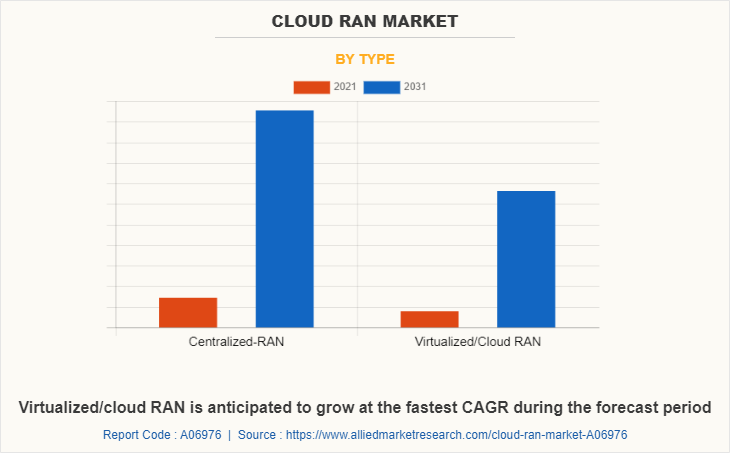
By type, the centralization technology sub-segment dominated the C-RAN market in 2021. A centralization technology comes with a variety of benefits, including the ability to use cutting-edge technology, resource virtualization, and ease of service deployment at the edge. A centralized BBU pool indicates that RRU are spread, but BBUs are housed at the network center. This makes it possible for C-RAN to outperform conventional cellular networks, which distribute BBUs, in a number of ways.
The first advantage is the ability to use cutting-edge technologies that require intensive processing and cannot be used in traditional networks. Because they can be installed in powerful data centers and have effective information sharing, BBUs can perform significant computing that is not possible in current networksAs a result, the C-RAN architecture will make it possible for collaborative processing and cooperative radio sharing technologies.
Furthermore, resource sharing is made possible with several BBUs that share a single pool, allowing for more flexible and demand-based allocation than in traditional networks. Due to the bigger pool of resources, this can increase resource usage, cause decreased power use, and increase user satisfaction. These are predicted to be the major factors affecting the C-RAN market size.
The virtualized/cloud RAN sub-type is expected to increase at the fastest rate. The virtualization of radio access networks is expected to ease carrier preparation for 5G by boosting bandwidth requirements. A 5G base station, for example, can theoretically boost system capacity and efficiency by deploying a collection of baseband units. By distributing signaling among cells, it makes it easier to position cutting-edge features that maximize the usage of resources and improve the user experience.
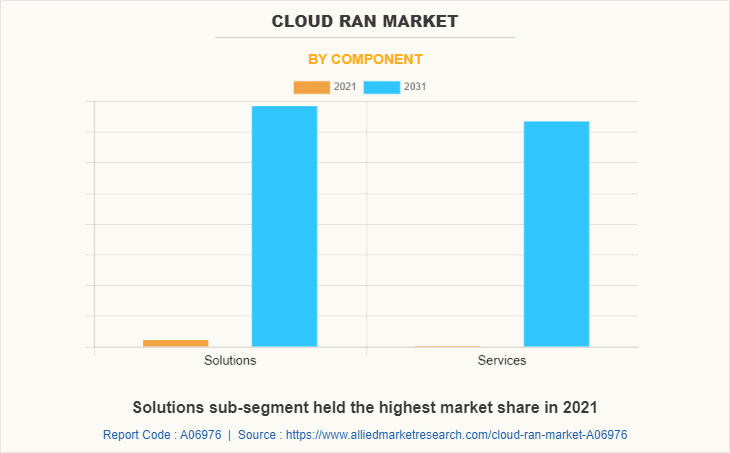
By component, the services sub-segment dominated the global C-RAN market share in 2021. To strengthen their presence in the global market, service providers are heavily investing in R&D and focusing on product development. Telecommunications network providers are aiming for overall network expansion and are concentrating their efforts on improving the 5G network. The use of C-RAN architecture by mobile operators is predicted to enhance demand for consultancy, maintenance services, design, and development. Furthermore, the increasing speed of technical advances is expected to drive cloud RAN industry expansion.
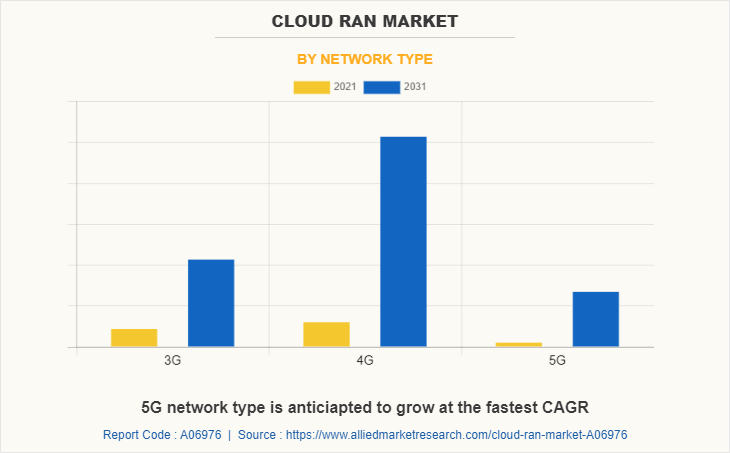
By component, the services sub-segment dominated the global C-RAN market share in 2021. To strengthen their presence in the global market, service providers are heavily investing in R&D and focusing on product development. Telecommunications network providers are aiming for overall network expansion and are concentrating their efforts on improving the 5G network. The use of C-RAN architecture by mobile operators is predicted to enhance demand for consultancy, maintenance services, design, and development. Furthermore, the increasing speed of technical advances is expected to drive C-RAN market expansion.
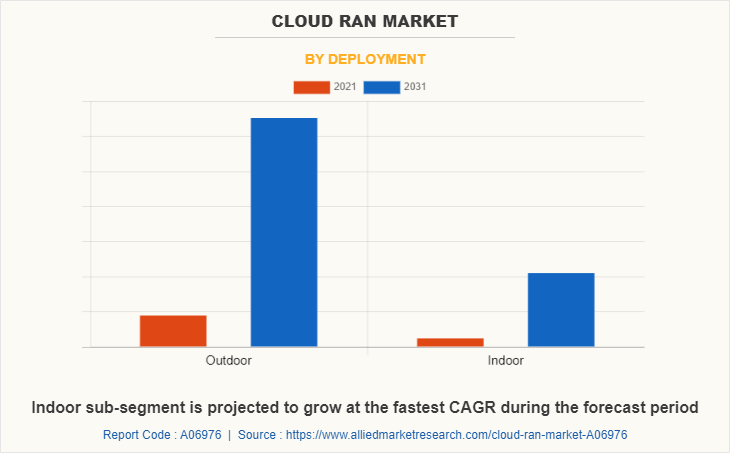
By deployment, the outdoor sub-segment dominated the C-RAN market in 2021. Malls, event spaces, and stadiums are the most common types of large public venues. These places are frequently occupied by users during the events. Base stations are frequently dimensioned for peak hours, which imply that when users gather during any events, a massive quantity of processing power is wasted in the regions. When compared to off-peak hours, peak traffic loads might be 10 times greater. Because these places are frequently occupied by many users during events, deploying C-RAN for them becomes necessary.
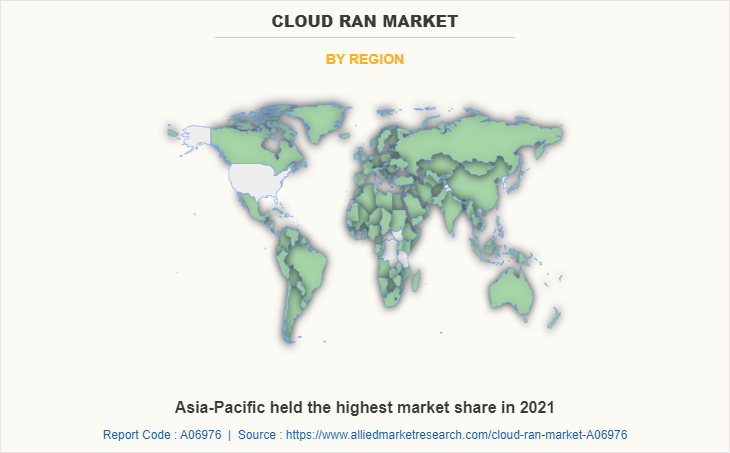
By region, North America held the highest Cloud RAN Market Share in 2021 and is projected to remain the fastest-growing sub-segment during the forecast period. North America is a leading destination, with telecom firms in the U.S. pushing hard to establish C-RAN. Initiatives are being conducted to set the groundwork for future 5G rollout by strengthening the network. Growing investments in C-RAN architecture implementation will boost market attractiveness throughout the projection period. The infrastructure is further divided into front-haul, baseband, and distant radio units. The increase in demand for consultancy, design & development, and maintenance services as a result of mobile operators' adoption of C-RAN architecture will contribute to market growth.
Impact of COVID-19 on the Industry
- COVID-19 has positively impacted the C-RAN market during the COVID-19 pandemic. The spread of novel coronavirus has sparked the demand for online channels and services.
- The COVID-19 pandemic has had a considerable impact on the global digital environment. To stop the virus's spread, several measures have been put into place, including social isolation and lockdown, highlighting the need for a successful and inclusive digital economy enabled by expanding access to dependable, adequate internet for socioeconomic well-being.
- During the COVID-19 epidemic, communication service providers have faced four operational obstacles. Security of network data, ensuring the continuity of operations, adjusting to new traffic patterns, and ensuring the quality of crucial services are some of these. As a result, the demand for cloud radio access networks increased due to the presence of strong security frameworks.
- During the COVID-19 pandemic, C-RAN technologies were leveraged in healthcare settings to enable rapid application deployment in individual organizations and data quality across organizations.
- Economic slowdown has affected the setup of new C-RAN projects across the world as majority of government funding were diverted toward healthcare sector owing to rapid spread of the COVID-19 virus, impacting the market to the great extent.
Key Benefits for Stakeholders
- This report provides a quantitative analysis of the Cloud RAN Market Forecast, segments, current trends, estimations, and dynamics of the cloud ran market analysis from 2021 to 2031 to identify the prevailing cloud ran market opportunities.
- The research offeres information related to the Cloud RAN Market trends, drivers, restraints, and opportunities.
- Porter's five forces analysis highlights the potency of buyers and suppliers to enable stakeholders make profit-oriented business decisions and strengthen their supplier-buyer network.
- In-depth analysis of the cloud ran market segmentation assists to determine the prevailing market opportunities.
- Major countries in each region are mapped according to their revenue contribution to the global market.
- Market player positioning facilitates benchmarking and provides a clear understanding of the present position of the market players.
- The report includes the analysis of the regional as well as global cloud ran market growth, key players, market segments, application areas, and market growth strategies.
Cloud RAN Market Report Highlights
| Aspects | Details |
| Market Size By 2031 | USD 85.9 billion |
| Growth Rate | CAGR of 23.4% |
| Forecast period | 2021 - 2031 |
| Report Pages | 340 |
| By Type |
|
| By Component |
|
| By Network Type |
|
| By Deployment |
|
| By Region |
|
| Key Market Players | ZTE Corporation, ERICSSON, Cisco Systems Inc., Huawei Technologies Co., Ltd., Altiostar, ASOCS Ltd, SAMSUNG, Nokia Corporation, NEC Corporation., Fujitsu Ltd. |
Analyst Review
Continuous technical advancements in the telecommunications sector, as well as the expanding popularity and sales of smartphones and tablets globally, are projected to propel the C-RAN market forward. In addition, C-RAN (cloud radio access network) offers important benefits such as lower power costs, increased capacity, and improved spectral efficiency. Furthermore, its ability to adapt to changing traffic patterns is expected to fuel growth of the market during the forecast period. However, stringent government regulations and the requirement to follow security standards are some of the reasons limiting the growth of the C-RAN industry. The mobile telecommunications sector is advancing rapidly owing to the 5G network type, in which C-RAN plays a critical role. Operators can save money using C-RAN in terms of both operating expenses (OPEX) and capital expenditures (CAPEX). Additionally, the C-RAN can improve network performance while lowering total cost of ownership (TCO)). In circumstances involving low-latency networks, C-RAN is important.
Among the analyzed regions, North America is expected to account for the highest revenue in the market by the end of 2031, followed by Asia-Pacific, Europe, and LAMEA. Rapid industrialization and urbanization are the key factors responsible for the leading positions of North America and Asia-Pacific in the global C-RAN market.
The global cloud RAN market size was valued at $11.1 billion in 2021 and is projected to reach $85.9 billion by 2031.
The cloud RAN market is projected to grow at a compound annual growth rate of 23.4% from 2022 to 2031.
FUJITSU, ZTE Corporation., Intel Corporation, Telefonaktiebolaget LM Ericsson, Cisco Systems, Inc., Huawei Technologies Co., Ltd., ASOCS Ltd., SAMSUNG, NEC Corporation, and Nokia are the major players in the C-RAN market.
Asia-Pacific will provide more business opportunities for the global C-RAN market in future.
The network architecture is changing as a result of increased demand for mobile data and the arrival of 5G technology. The infrastructure of the current radio networks is being put to the strain by the exponential growth of network traffic and the scarcity of spectrum. As a result, C-RAN technology presents chances to raise network capacity while also lowering total cost of ownership.
Loading Table Of Content...



